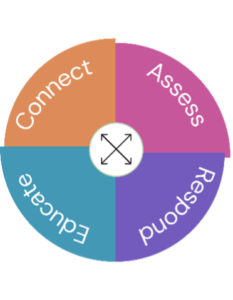C.A.R.E. for older adults experiencing social isolation and loneliness
“I will now be sure to incorporate asking about loneliness, to obtain a subjective understanding from my patients.”
– Health and Social Service Provider
CCSMH is celebrating the first anniversary of the launch of the Canadian Clinical Guidelines on Social Isolation and Loneliness in Older Adults (SILOA). Thanks to the generous support of the Waltons Foundation, we have the opportunity to mobilize the clinical guidelines into action with health care and social service professionals across Canada. We have been working on this over the past 12 months. We’ve attended 14 conferences, presented multiple webinars, published papers, and partnered with organizations and individuals to put the 17 recommendations into practice. The clinical guidelines highlight the importance of “opening up the conversation about social health,” using evidence-based assessments, documenting and tracking, and taking an individualized, patient-centered approach. As well, many subject matter experts and their organizations, both clinical and academic, from across Canada, are lending their knowledge and experience to the mobilization and implementation of the recommendations.
Did you know?
“I did not make a distinction between social isolation and loneliness in the past. I assumed one usually led to the other. I also did not consider if a person felt lonely even if they were not isolated.”
– Health and Social Service Provider
Social isolation and loneliness are related but distinct concepts. This can sometimes lead to assumptions about who might be lonely.
Social isolation is a measurable deficiency in the number of social relationships that a person has. An objective deficit in connections to family, friends or the community.
Loneliness is an internal subjective experience; it is an unpleasant sensation felt when a person’s social relationships are lacking in quality or quantity compared to what they desire. It is a subjective assessment that social relationships are lacking.
What about solitude? There are benefits to spending time alone including: increasing empathy; increasing productivity; sparking creativity; building mental strength; having time to plan your life; benefitting children, and; helping you to know yourself.
The effects are significant
“The importance to seniors’ mental and physical health is a priority.”
– Health and Social Service Provider
Not surprisingly, loneliness and social isolation are associated with higher rates of depression, and anxiety. They also impact a number of physical and cognitive comorbidities such as dementia, stroke, coronary artery disease, disability from chronic diseases, reduced quality of life, and an increased number of falls. One study compared the effect of isolation to smoking 15 cigarettes per dayi. Loneliness & social isolation are also associated with an increased risk of death (26% and 29%, respectively).
What’s next?
“Many of the older adults I connect with experience some form of social isolation and loneliness. This can include care partners who may have withdrawn over time as a result of their caregiving commitments and not even be aware as to how isolated they have become.”
– Health and Social Service Provider
Building on the E.A.R. framework developed by Dr. Julianne Holt-Lunstad and Dr. Carla Perissinotto,ii CCSMH is developing C.A.R.E.: Connect, Assess, Respond, Educate. This holistic framework is an effective, evidence-based treatment pathway from initial interaction through treatment and resolution. Using C.A.R.E., health care and social service professionals can address social isolation and loneliness among older adult patients.
Connect
- Building rapport with patients through compassion, empathy and active listening.
- Creating space for and comfort with the topics of loneliness and isolation.
Assess
- Document social support, isolation, and loneliness in the medical record.
Identify patients/clients at risk with the use of validated measures of SI & L.
Track risk and progress over time.
Respond
- Reinforce the need for social connection alongside other health risks and protective factors.
- Integrate psychosocial support from all members of the care team (e.g. clinicians, volunteers, family, care partners) into a patient’s treatment.
- Offer referrals tailored to a patient/client’s need and partner with local community resources.
Educate
- Social connection is part of a healthy lifestyle and affects risks for illness and death.
- Social connection helps patients/clients maintain their health, manage existing medical conditions and adhere to medical regimes.
In 2025, CCSMH will be launching new tools and resources to help HCSSPs implement the clinical guidelines, including two conversation guides and a collaborative C.A.R.E. tool.
Learn more about social isolation and loneliness in older adults
CCSMH is a trusted source of information about social isolation and loneliness in older adults. You can learn more by downloading the guidelines, purchasing clinician and patient resources, and visiting our website.
i Holt-Lunstad J, Robles TF, Sbarra DA. Advancing social connection as a public health priority in the United States. Am Psychol. 2017 Sep;72(6):517-530. doi: 10.1037/amp0000103. PMID: 28880099; PMCID: PMC5598785.
ii Holt-Lunstad, Julianne & Perissinotto, Carla. (2023). Social Isolation and Loneliness as Medical Issues. New England Journal of Medicine. 388. 10.1056/NEJMp2208029.

